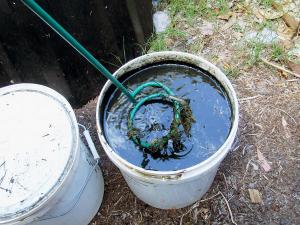Unflavored gelatin makes for an excellent fertilizer
In the late 1890s a LeRoy, N.Y. carpenter and his wife added strawberry, raspberry, orange and lemon flavoring to powdered gelatin and created Jell-O-O. From there it was a quick leap to gelatin salad, that all-too-common summer treat of salad made with flavored gelatin, fruit and occasionally grated carrots.
Church suppers may even find gelatin with cottage cheese, marshmallows, nuts and even pretzels ensconced as if floating in the translucent gelatin.
Pure unflavored gelatin can be used as a homemade organic fertilizer. Liquid fertilizers are popular because, just like Jell-O salads, they can be made in advance and are fast acting.
Just dissolve the unflavored gelatin in hot water, let it cook and dilute it with plenty of water and you have a nearly all nitrogen liquid fertilizer.
Liquid fertilizers are vital to container-grown plants, because they depend entirely on a limited amount of soil for nutrients. Houseplants or any container-grown plants grow best with frequent light feedings of liquid fertilizers.
While unflavored gelatin provides lots of nitrogen, most plants need phosphorus and potassium too. Add phosphorus and potassium to your plants by chopping up all of your banana peels and putting them in a jar of water. After a week or so, use this banana peel liquid on your blooming houseplants.
Common Epsom salt also contains important plant nutrients - magnesium and sulfate. Add a tablespoon of Epsom salt to a gallon of water, stir well, and use it on all of your houseplants. Use Epsom salt water outdoors on roses, peppers, tomatoes, and potatoes.
You can make outdoor liquid fertilizer in a large bucket. Good old grass clippings covered in water and left to steep for three days will produce a wonderful liquid fertilizer.
A word of caution: do not let any liquid fertilizer sit for more than two or three days or it will begin to ferment. Once it ferments, not only will the chemical make up change, but your fertilizer bucket will stink to high heaven. Nitrogen held in your outdoor soil is hard for plants to absorb when soil temperatures are below 50 degrees Fahrenheit. Early spring crops such as Swiss chard, lettuce, broccoli and cabbage will respond well to liquid fertilizers.
Flowering plants and vegetables use the three major plant nutrients of nitrogen, phosphorus, and potassium, in a ratio of about 3-1-2: that is three parts nitrogen, one part phosphorus, and two parts potassium. Therefore, a fertilizer with an N-P-K ratio of 3-1-2 is better balanced for most plants than the common ratio of 1-1-1.
Luckily your homemade liquid fertilizers are meant as quick nutrient boost so they don’t need to be exactly balanced. Grass clipping “tea” comes very close to supplying the right components in the optimum 3-1-2 ratio.
Water your plants with homemade liquid fertilizer no more than once every two weeks. For best results, watering before you fertilize helps your plants from taking up too many salts.
Because of evaporation, containers that are regularly fed liquid fertilizer may show a white crust of accumulated salts on the soil surface. Drench the plants with several buckets of water to wash these salts, and it will be safe to keep feeding the plants with homemade liquid fertilizers. Whether you use grass clippings, unflavored gelatin or banana peels, you’ll be pleasantly surprised by the ease of making your own liquid fertilizers. And it sure beats another church social with vegetables floating in a Jell-O salad.
























































